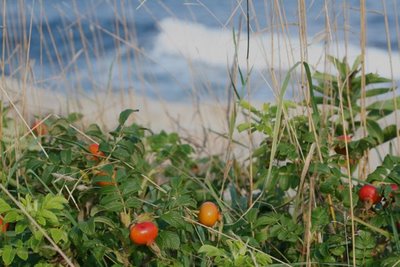 Rosa rugosa, an Asian import, bears its cheerful orange hips against the sea spray. There aren't many exotics that seem to belong, but this lovely plant, with its giant single pink or white flowers, its pure attar-of-rose scent, and its edible hips, feels right to me.
Rosa rugosa, an Asian import, bears its cheerful orange hips against the sea spray. There aren't many exotics that seem to belong, but this lovely plant, with its giant single pink or white flowers, its pure attar-of-rose scent, and its edible hips, feels right to me.It is good, especially in fall, when melancholy seems always to wait in the wings, to go someplace, someplace utterly different than home, as beautiful as home is. It satisfies some ancient urge in us to be moving, changing scenes, I think. I am gratefuul to Swarovski North America for taking me out to Cape Cod and letting me remember that somewhere, there are shorebirds flocking and waves pounding distant shores.
The herring gull told the season in the worn banners of its primary feathers. Melanin, the black pigment, strengthens wingtips against wear, but the decorative white spots, which birders call mirrors, melt completely away with the friction of the constantly beating air. This is why even pure white birds like ibises and snow geese accessorize with black wingtips. Black-billed magpies have a fringe of black around their white flight feathers. It's all about preventing excess wear.
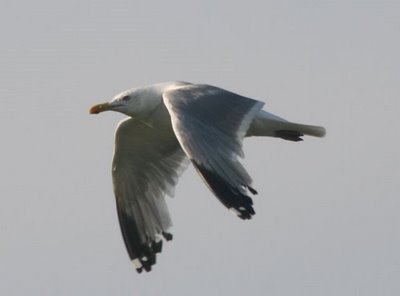
They were massing, these birds, for the flight south; had already completed quite a leg of it. Hudsonian godwits nest where the midnight sun never sets--way up on Hudson's Bay.
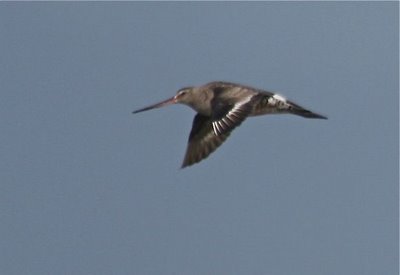
A sanderling clung to its breeding plumage, but it was fading fast. Soon it would be winter-white, the whitest sandpiper around.
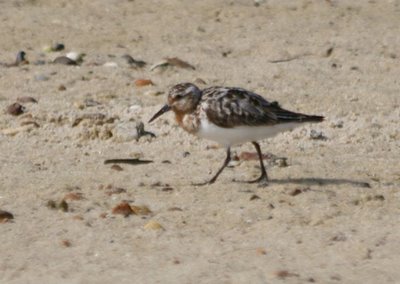
By some miracle, I was able to focus on these short-billed dowitchers without aid of my (disabled) image stabilizer. Hey, sometimes lightning strikes. Look at the uppermost bird-- how the white rump stripe runs all the way up their backs. The pale inner wing feathers--the secondaries--are distinctive, too. But the only easy way to tell them from long-billed dowitchers is by their toodleoodleoodle call. (long-billeds have a single note).
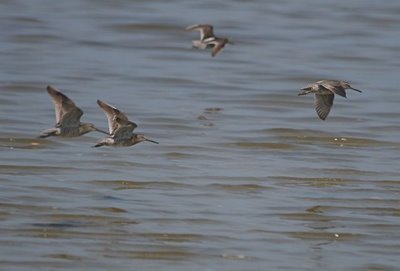
A roseate tern shone like quicksilver in the mass of darker common terns. His nasal zaaap! call rang out over his companions' keening complaints.
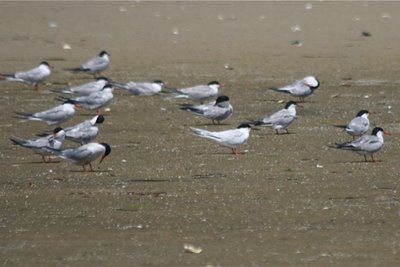 Roseate terns are endangered; a frighteningly large percentage of the population nests on Bird Island off Cape Cod; other outliers are scattered throughout the Northeastern coastal islands. They depend for their survival on wise gull management; where there are nesting gulls, there will be no roseate terns nesting. Roseate terns, like Atlantic puffins, are completely dependent on people to fight back the gulls we encourage with lobster bait, landfills, and pizza. Relax our vigilance, allow the gulls to nest on tern islands, and the tern eggs and young simply vanish down gull throats.
Roseate terns are endangered; a frighteningly large percentage of the population nests on Bird Island off Cape Cod; other outliers are scattered throughout the Northeastern coastal islands. They depend for their survival on wise gull management; where there are nesting gulls, there will be no roseate terns nesting. Roseate terns, like Atlantic puffins, are completely dependent on people to fight back the gulls we encourage with lobster bait, landfills, and pizza. Relax our vigilance, allow the gulls to nest on tern islands, and the tern eggs and young simply vanish down gull throats.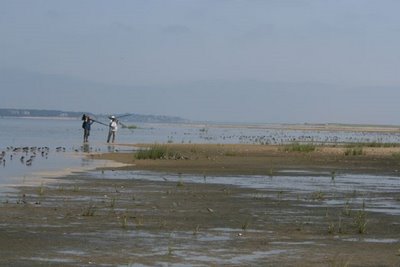
Oh, it was good to be surrounded by shorebirds.
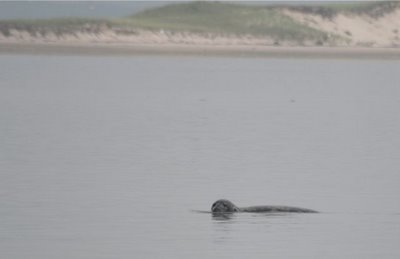
And how couuld I forget the young male gray seal who was slooshing around our landing site in a desultory way? Gray seals are a recent phenomenon on Cape Cod, having moved well south of their traditional pupping areas to breed on offshore islets in Massachusetts. Sometimes called "horseheads," they're huge, and more imposing than the little round-headed harbor seals. What a cool sight, one I'd only seen in Newfoundland or on Maine's Monhegan Island prior to this.
Looking up
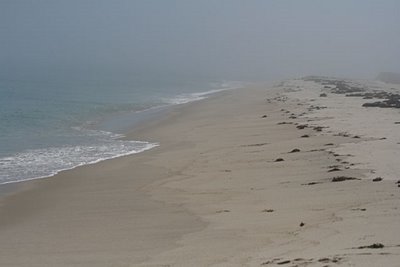
and down the misty beach soothed my soul.
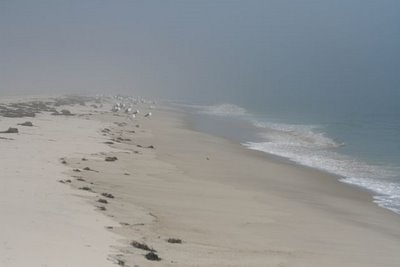
There's another post beneath this'n; don't miss it! Yesss, sometimes the Ant posts twice.






12 comments:
It has been ages since we visited Cape Cod, but I did so love the place. I looked at those wonderful beaches and thought--this is what the Atlantic seacoast was meant to look like, not the tawdry trumped up absurd buildings we have littered the sand with.
Be careful, or that seal will want to take you for a wife!
The misty beach. Ooooo. Thanks for another wonderful post and especially for the walk on the beach. Miss it. Love it.
Ahhh I am making my annual pilgrimage to Cape Cod in the next month....I can hardly wait! Great to see your pictures and learn more about the flora and fauna!
So much beauty in this post. Worn feathers, sanderlings hanging on to some color as Autumn approaches.
And that beach! It's lost in time.
Thanks for the reminder of all that I take for granted so close to home... I love living near the shore!
"toodleoodleoodle call"? ...LOL I love to read you!
I wonder if you aren't a Cancer-child. I was born in July...and feel the same way about the ocean that you seem to feel. Thank you for the wonderful 'fix'.
Beverly
Thanks for the trip out to see shorebirds! We have lots of pristine beaches left up here in the North East. I just hope our modern society can recognize how important they are. Thanks for the Roseate Tern. I have never seen one.
Interesting factoid about the melanin...Our glaucous-winged gulls lack the black wingtips, and their primaries are quite hammered by the time they molt...Now I know why!
Julie, I am constantly amazed at both the depth and extent of your "science chimp" knowledge, and the skill with which you share that knowledge. I never knew the importance of the black wing-tips.
Loved the images of the misty beach, too. I can almost feel the tingling moisture on my arms and smell the salty air of the shore.
Cool! You got a shot of the seal!
I agree...thanks for the tidbit regarding the melanin; who knew? Perhaps that’s why the leucistic eagle they found near here was in such bad shape (I mentioned him in July). Maybe the melanin, in toughening the feathers, also strengthens them against mites. Now you have me wanting to go read up and see what about ‘dark’ does this… I like that about your blog!
Post a Comment